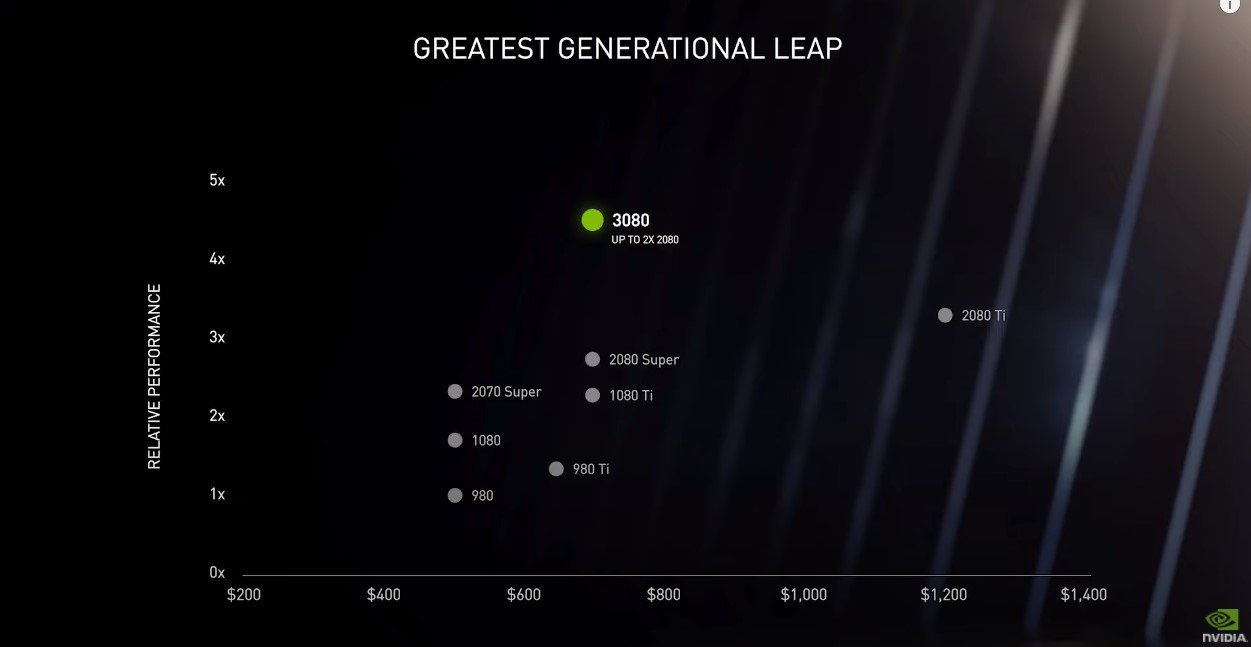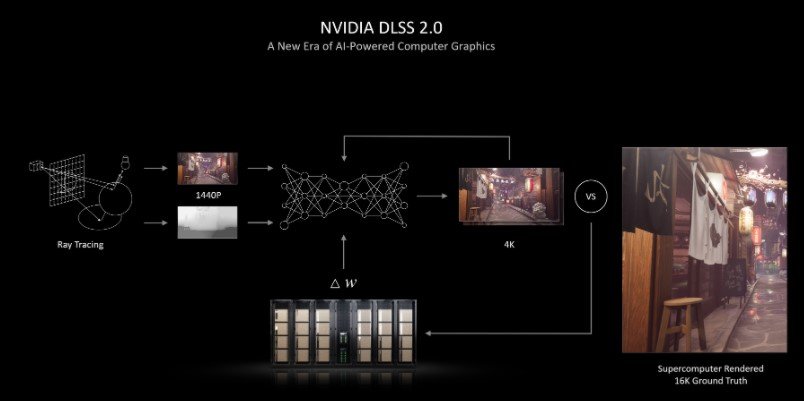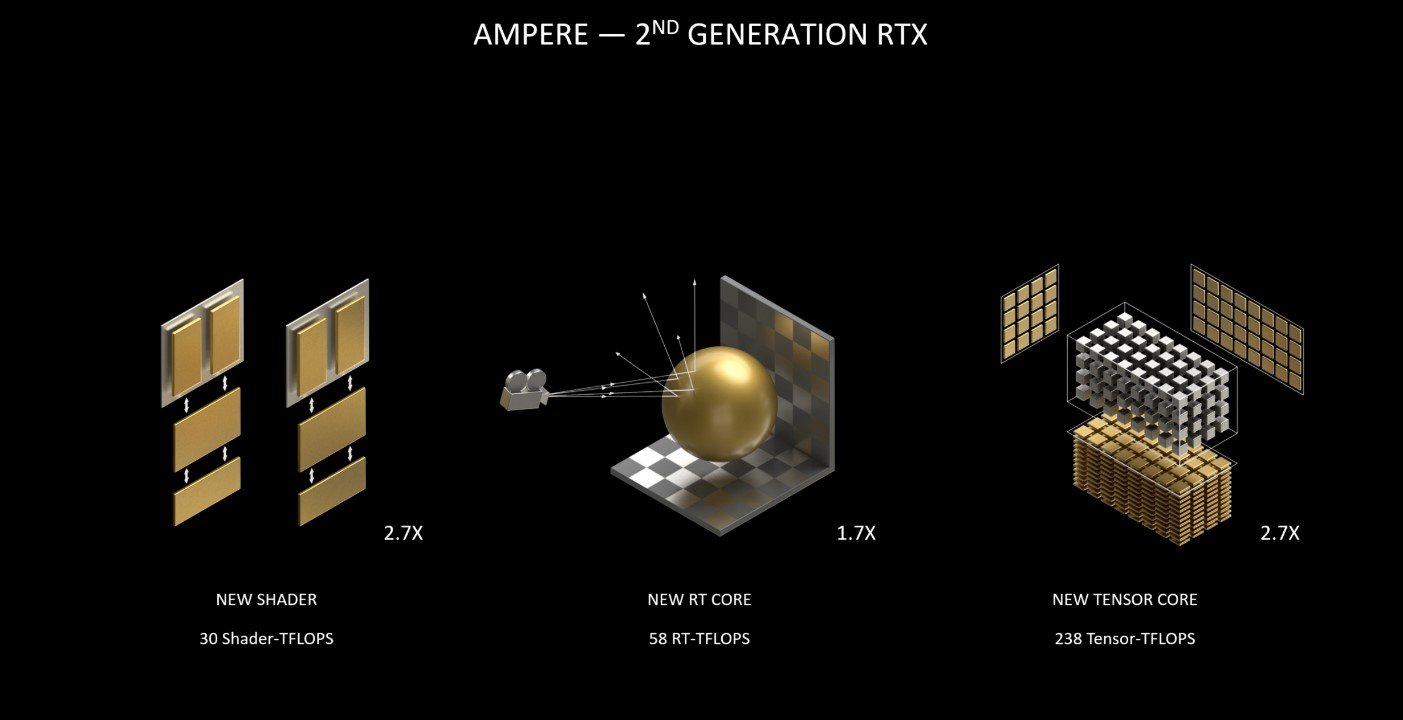NVIDIA GeForce RTX 30 Series graphics cards: Announcement details
Read the original article here.
After months of hype and build-up, NVIDIA finally gave consumers what we’ve all been waiting for: the reveal of their GeForce RTX 30 Series GPUs. The announcement stream went live at 9 am, and NVIDIA’s CEO Jensen Huang greeted us from his kitchen (now a familiar occurrence in 2020) and promised us an “amazing GPU”. Without further ado, let’s get into the incredible announcements made this morning.
First, let’s cover the big reveals.
GeForce RTX 3080, 3070, 3090
With a fully redesigned carriage, the new 3080 GPU is a beautiful feat of engineering. Sporting a top and bottom fan, the 3080 and 3090 implement a heat exhaust system that improves airflow, runs nearly 20 degrees cooler than the 20 Series GPUs, and 3 times quieter.
The new 3080 has doubled the performance of the current 2080 Super, and is 1.5x the speed of the current 2080 Ti. It is self-proclaimed by NVIDIA to be the greatest generational leap in GPU history.
You might be thinking, “that’s nice, but I bet it costs an arm and a leg.” Nope! The brand new 3080 is the same price as the current 2080 Super. Costing a modest $699, the new flagship from NVIDIA is available September 17, 2020.
Second in line, the GeForce RTX 3070 is the smaller and cheaper counterpart to the 3080. Offering performance greater than the current benchmark of the 2080 Ti, and costing less than half of the Ti’s astronomical price, the 3070 is fully prepared to send big waves of transformation through the PC community. Huang personally took the time to address all the Pascal loyalists, letting them know: now is finally the time to upgrade. The 3070 weighs in at an easy $499, and launches in October of this year.
Last but definitely not least, NVIDIA revealed its self-described “BFGPU”: the GeForce RTX 3090. This hunk looks like it could rival my entire PC in a welterweight match.
Ten times quieter than the Titan RTX, and 3 times cooler, the 3090 walks softly and carries a big stick.
Using DLSS 2.0, the 3090 generates 8K frames with 60fps framerates. Because neither a typical monitor, nor YouTube, can show 8K: NVIDIA showcased a sizzle reel of streamers invited to their headquarters to experience 8K. Does the average consumer need 8K resolution? Absolutely not. Do we want it anyway? Yes, yes we do.
The 3090 will be a crispy $1499, and will be available September 24, 2020.
Aside from the new products, NVIDIA had a ton of additional announcements to share.
NVIDIA’s “Four Gifts”
First and foremost, in what might be the biggest gaming news of the day: DLSS and real-time ray tracing enhancements are coming to Fortnite.
NVIDIA Reflex was also announced, set to come out this September. Reflex is firmly aimed at esports. It will launch as a Game-Ready Driver update that will optimize the CPU-GPU pipeline to improve latency “by up to 50 percent,” according to Huang. The first games to receive this update will be Riot Games’ VALORANT, Epic’s Fortnite, EA’s Apex Legends, Activision’s Call of Duty: Warzone, and Bungie’s Destiny 2.
Next, brand-new G-Sync displays that run at a whopping 360 Hz were unveiled. Big hitters such as Acer, Dell’s Alienware, ASUS, and MSI will be launching these monitors this fall. Again, esports took center stage here, as reduced latency in player movement was highlighted for competitive gamers.
Lastly, NVIDIA Broadcast was announced. Broadcast, launching this September, will give both amateur and professional content creators more tools to work with when creating webcam videos. The three main features highlighted were audio noise removal, virtual background effects, and webcam auto framing, all utilizing AI tech. As someone who knows the basics of keying and rotoscoping in Adobe’s After Effects, virtual background effects in real time has massive implications for the many hours it takes to create content.
Omniverse Machinima
Huang moved into speaking about NVIDIA’s new Omniverse Machinima application, which addresses “Machinima,” a form of art that takes real-time computer graphics engines and creates short films or animations with them. This application will be available on Omniverse, NVIDIA’s workflow collaboration tool. It is a “universal design tool asset exchange with a viewer, based on photorealistic path tracing.” If you didn’t understand anything in that sentence, it’s because it was Satanic blasphemy and you may have just summoned a demon. On a more serious note, this application is a massive success in sharing assets across different design platforms. It will support 3DS Max, Maya, Photoshop, Epic Unreal, Rhino, and other third-party design applications.
DLSS 2.0
Next up? DLSS 2.0. Let’s break it down. Using artificial intelligence, DLSS takes in the low res image in a current frame, as well as the previous high resolution frame to generate a high resolution current frame without sacrificing runtime. Essentially, DLSS is implemented into the Game-Ready Driver to allow for 4K gaming with higher framerates, and that’s good for everyone. DLSS 2.0 takes this a step further for the new 3090 GPU.
RTX IO
Huang discussed the current state of computer operations in some detail, describing how the GPU-CPU pipeline is the new “bottleneck”, rather than memory, due to the speed of NVMe SSDs. Because of this, NVIDIA has developed RTX IO. Working closely with Microsoft, RTX IO will utilize DirectStorage and will streamline the GPU/CPU transfer to be nearly 20x faster than the previous generation of GPUs. With lossless decompression and advanced APIs made specifically for gaming, RTX IO brings gaming one step closer to the dream of zero load-times.
Ampere
Utilizing Ampere, the new and improved GPU system built upon the bones of the previous Turing system, NVIDIA has truly outdone themselves in performance specs for the new GeForce RTX 30 Series.
Here are the specs for the Turing system, or the first generation RTX:
Pretty impressive, right? Now, let’s look at the phenomenal increase in performance for the Ampere system, or the second generation RTX, launching with the 30 Series:
As shown, the Ampere architecture has doubled Turing’s performance on every level.
That wraps up the enormous amount of information NVIDIA packed into 40 minutes today, and wow are we excited to get our hands on the 30 Series GPUs. Check back on Newegg Insider for all the latest news, and be sure to pick up your very own NVIDIA GeForce RTX 30 Series from Newegg later this month.
Want more info on the NVIDIA launch? Check out NVIDIA’s full recap of the event, as well as the reveal itself. You can also visit the GeForce RTX 30 Series launch page.












